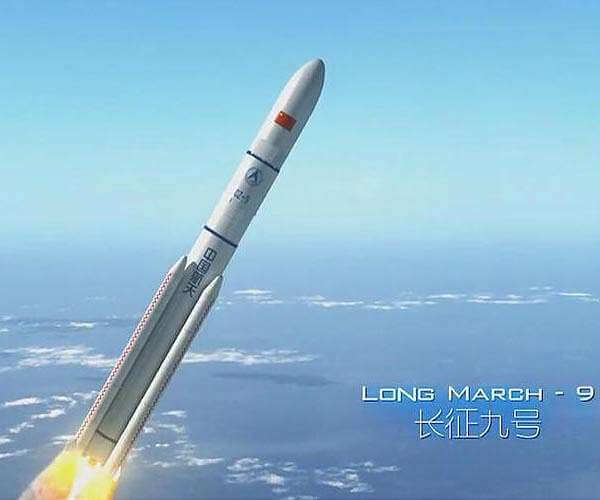
Structural details of Long March 9 revealed (Image Credit: Space Daily)
Chinese rocket researchers are now definite on the overall structural design for the nation’s super-heavy carrier rocket, known as the Long March 9, a project insider said on Wednesday.
Gu Mingkun, a senior rocket designer at the China Academy of Launch Vehicle Technology, the country’s leading rocket maker, said at a news conference that the baseline model of the Long March 9 will be a large, three-stage rocket about 110 meters tall.
It will have a liftoff weight of about 4,000 metric tons and thrust power of nearly 6,000 tons. The diameter of its core stage will be about 10 meters, he said.
According to the designer, the rocket will be powerful enough to transport spaceships weighing up to 50 tons to an Earth-moon transfer trajectory for lunar missions, such as the construction of a large-scale science outpost or mining.
It will also be able to send spacecraft on deep-space missions, including an ambitious venture to place Chinese astronauts on Mars, Gu said.
In addition to the baseline model, the structure of another model for spaceflights to low-Earth orbit has also been determined by researchers, he said.
The second model will have two stages, which means it will be shorter than the baseline one. It will be capable of deploying spacecraft with a combined weight of 150 tons to a low-Earth orbit hundreds of kilometers above the ground, the designer added.
The rockets’ first stage, which has the strongest lift power, will be reusable on both models and extensively reduce operational costs, he said.
Once Long March 9 enters operation, its carrying capacity will be more than five times that of Long March 5, currently China’s most powerful rocket.
“The super-heavy rocket will greatly help expand mankind’s reach inside the solar system, establish a shared future in outer space for all people and extensively boost the unity and confidence of the Chinese nation,” he said.
“Its design and manufacturing work will inject momentum into a number of engineering fields including the advanced high-performance materials and key electronic components.”
Currently, the biggest and most powerful rocket in service in the world is the Space Launch System, a super heavy-lift model developed by NASA. The SLS, which took its maiden flight on Nov 16, also has multiple configurations.
Gu made the remarks at a news conference in Beijing held by China Aerospace Science and Technology Corp, the country’s dominant space contractor and the parent company of Gu’s academy. The event was held to launch the Blue Book of China Aerospace Science and Technology Activities in 2022 and make public the company’s future research and development plans.
Related Links
China Academy of Launch Vehicle Technology
Rocket Science News at Space-Travel.Com
|
|
Tweet |
|
|
|
We need your help. The SpaceDaily news network continues to grow but revenues have never been harder to maintain. With the rise of Ad Blockers, and Facebook – our traditional revenue sources via quality network advertising continues to decline. And unlike so many other news sites, we don’t have a paywall – with those annoying usernames and passwords. Our news coverage takes time and effort to publish 365 days a year. If you find our news sites informative and useful then please consider becoming a regular supporter or for now make a one off contribution. |
||
|
SpaceDaily Monthly Supporter $5+ Billed Monthly |
SpaceDaily Contributor $5 Billed Once credit card or paypal |
|
SEXBOMB being moved to Cornwall Space Port for hypersonic developments
Edmonton, Canada (SPX) Jan 17, 2023
Space Engine Systems Inc. (SES) is a Canadian based company that claims to be a trucking company to anywhere in space and mainly focussed on the Lunar Mission.
SES space planes use air breathing combined cycle engines to get to space. The rocket engines kick in only after a very high altitude. They have Hello-1 X demonstrator which is planned to be launched from the US this year (2023) subject to regulatory approvals. Hello-1 can carry 550 kg to LEO. Hello-2 will carry 5,500 kgs to LEO and can car … read more









